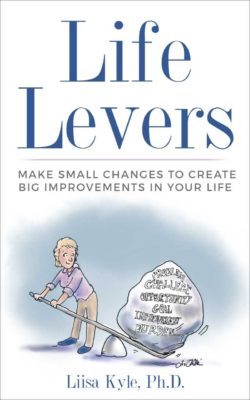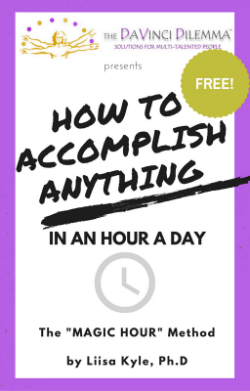A confession: I’m an organization nerd. Call me crazy but I enjoy being able to find what I need when I need it — be it a particular tool, invoice, ingredient or garment. It feels good to have my ‘to do’ lists prioritized, to know that the important things are not falling through the cracks. A well organized drawer gives me tingles. Given my tendency to be a neatnik, I adore organizational products of all description. Anything that helps capture ideas or manage tasks or impose some order on a project is a beautiful thing, in my book. It’s difficult for me to go to an office supply store or IKEA or a discount store without browsing for new ways to get organized. When I discover a new organizational product — like I did this week — that will help a coaching client or friend or colleague manage their talents more effectively, it makes me very, very happy.
So what’s my newest discovery? A strong but flexible plastic box, about a foot square by 4 inches wide that buckles closed. It has a strap for carrying — meaning that the contents are contained and portable. Inside is a plastic accordian file — a dozen separate polymer slots for organizing their contents, each with a tab you can label. These slots are perfect for capturing and sorting bits of paper or files or sample materials or photos or clippings or ticket stubs or napkins with great ideas scrawled on them. At the back of the box, there’s an empty wider space — perfect for toting bulkier items like tools, books and supplies — or more files if you prefer. This is the kind of organizational product that would be perfect for housing photos, recipes, financial papers, etc. — not to mention the purpose for which it was designed: scrapbooking. For DaVincis — creative people managing many talents, ideas and projects — it could be used to organize and manage things like:
* items relevant to a particular talent
* ideas, plans and resources for a particular project
* a “Balance Box” in which each section is devoted to an Important Area of Life
* a special event
When I espied this device, I actually squealed with joy, scooped up an armload and sprinted to the cashier. Within an hour of arriving home, I’d customized one for a colleague and devoted another to my home renovations. A third one became “Control Central” for my metal creations. A fourth is devoted to songwriting…and that’s just the beginning. I may well replace my hanging file folder system with a sequence of these boxes, they work so well.
Now I’m telling you about this box, not as an endorsement of a particular company or product, but rather as a way of demonstrating the delights and utility of an excellent organizational aid — it’s practical, functional and can fulfill a zillion functions. It reduces stress, imposes order and enhances efficiency. These are but some of the benefits of being organized.
In my coaching practice, I’ve helped a lot of DaVincis get organized. My recent discovery of the box prompted me to think about other organizational products that work well for creative people. Here are some of my favorites:
If you are a visual organizer — more of a ‘piler’ than a ‘filer’ — then I hope you have a stationary sorter. This is a nest of cubbyholes into which you can stack materials and ideas. You can have different cubbies for different talents — or different projects — or both. This practical alternative to file folders has transformed the lives of many of my coaching clients. There’s no law that says you must organize things into files. Piles work just fine, assuming they are orderly piles, like those you create in a stationary sorter.
2. Book Shelves
Oh sure, you can use your bookshelves to store your books — but they’re also a highly effective way to store your projects in progress. Think of them as huge ‘stationary sorters’. You can use each shelf to hold materials and equipment for a given project — or you can devote each shelves to house the works, materials and tools of a particular talent.
If, like me, you don’t like the messy appearance of your project piles — or if the sight of them is a distraction for you, guess what? You can put opaque doors on bookshelves. When you close the doors, you hide mess and avoid the distraction.
This is a point worth emphasizing: putting things in order is a way of reducing stress and visual chaos. An orderly work surface is less distracting. It’s also more efficient because you can work without first (a) locating the approximate position of your desk, (b) relocating the clutter that’s on it, (c) fighting whatever tempting distractions and new, tangential ideas that emerge as you unearth your work surface and (d) digging back through the clutter, seeking relevant materials and supplies for whatever it was you wanted to sit down and do…if only you can remember what that was.
3. Lidded Cardboard Storage Boxes
Think of a generic version of the cardboard boxes that photocopy paper comes in: plain cardboard boxes with built in handles and removable lids. I usually buy mine in flat packs of ten. They store easily until they’re needed, when it just takes a few seconds to fold the flat pieces into boxes and lids.
You can use these to hold whatever fits in an 10 ” x 12″ x 15″ space — things like files or tools or projects or supplies.
To the extent that you have the space to store them handily, I recommend you devote a separate box to every project that’s important to you — past, present and future. Start by taking all your current projects. Label separate boxes for each project. Now load them up with their relevant materials. (It’s fine if a given project requires more than one box). Got an idea for a new opera you want to tackle next year? Label a fresh box with its working title. As you collect relevant ideas or materials for your opera, add it to your ‘new opera’ box. What about that half-done novel you stopped writing five years ago? Put your most recent draft plus any relevant files, materials or resources into it’s very own, labeled storage box. It’s at the ready if ever you want to re-start it — and if you don’t choose to finish it, that’s fine too. DaVincis would be sad indeed if we ‘had’ to finish everything we start.
Cardboard storage boxes work well with DaVincis who are overwhelmed or resistant to get organized. Getting organized doesn’t have to be big deal. Just shovel your stuff into separate, labeled boxes. You’re done. If you so desire, you can further organize the contents of each box — but it’s not required. Just putting your things into relevant boxes will help tremendously. NOW, when you need a particular tool or invoice, your don’t have to search through everything you own — your search is limited to the interior of one box.
4. The Labeler
When I mention the labeller as an organizational product, some clients scoff. (I scoffed myself, before I actually tried using one, so I empathize completely). Here’s what I know: the labeler is a magical device that will bring newfound order to your world, if you let it.
For years, I used calligraphy to make my file folders, idea books and scrapbooks neat, well organized and attractive. Or so I thought. Then I got a labeler and my world was rocked. I can’t explain why but proper printer labels make all the difference. There’s a certain peacefulness about plain type, perfectly proportioned. It’s clear, easy to read and visually soothing. Now I begin each year and with fresh manila folders, each plainly labeled. My pantry items are in clear jars, each with a labeled top. Labels grace my storage bins, project shelves, tool drawers, stationary sorter cubbies and art supplies. I even use it in my scrapbooks to add titles or background information — so much faster than using alphabet stickers and so much neater than handwritten notes.
5. Sticky Notes and Sticky Tabs
Keeping your activities organized doesn’t have to be expensive or complicated. My main organizational aid during graduate school was a piece of 8″ x 11″ paper, covered with sticky notes. One sticky note was a ‘to do’ list for one research project; another sticky note were my ‘to dos’ for a different project. A third sticky note captured ‘Coursework’ items while a fourth listed “Teaching” tasks. Other stickies recorded my progress on daily and weekly quotas as well as my ‘domestic to dos’. As new projects or priorities emerged, they got their own new sticky.
What works about this ‘system’ is that it’s fast, cheap, easy, infinitely flexible, portable and visual: you can see at a glance, everything that needs doing — but these things are contained on separate stickies, so they are orderly and manageable. You can color code your activities if you wish, using different colored stickies for different lists. Best of all, every day you’re guaranteed to get the little thrill inherent in literally crossing items off your ‘to do’ lists.
Sticky tabs are for more than just flagging a book passage or indicating where a signature is needed. Sticky tabs are great for organizing idea books. If you take any blank book and slap some sticky tabs on it to divide it into relevant sections, you can use it to simultaneously capture and organize your ideas.
*****
This is not an exhaustive list of organizational products by any means, but it does highlight some of what seems to work well with DaVincis like you. If you are wanting to get organized, give them a try and see what you think.
*****
Activity: Think back — what organizational products have worked well with you at different times in your life?
Activity: Review this list of organizational products. Is there something mentioned that you haven’t tried yet? Why not give it a spin?
Activity: The next time you’re in an office supply store or IKEA or a discount store, browse the aisles for other organizational products.
***
 Want more tips and techniques for getting things done? Check out my book YOU CAN GET IT DONE: Choose What to do, Plan, Start, Stay on Track, Overcome Obstacles, and Finish
Want more tips and techniques for getting things done? Check out my book YOU CAN GET IT DONE: Choose What to do, Plan, Start, Stay on Track, Overcome Obstacles, and Finish
Available here in Paperback and Ebook format: http://bit.ly/YouCanGetItDone
***
If you’d like to share or publish this article, you may, if you include the author’s name, a link to this original post and the following text blurb:
Are you struggling with too many talents, skills, ideas? You may have The DaVinci Dilemma™! Find tools, fun quizzes, coaching, inspiration and solutions for multi-talented people at http://www.davincidilemma.com/.




Hi Liisa and Lisa,
How come I don’t see my previous comment/suggestion re: organization? When I read one of your newsletters last year, you asked HOW DO I ORGANIZE MY MANY CREATIVE PROJECTS? I answered it by creating The Wiz Kit!! This unique creative organizing system is PERFECT for us Da Vinci Divas!! I’m truly surprised you have not highlighted it or gotten in touch.
If you have any questions, please let me know- Thanks!!
All the best to you,
Giana